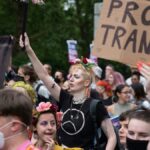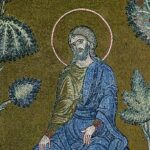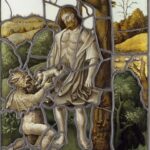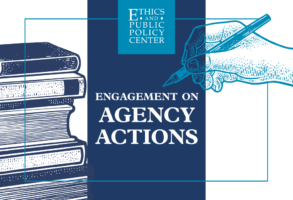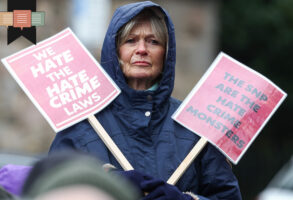Published January 14, 2014
The religious dimension of the EuroMaidan protests in Ukraine these past two months has gone largely unremarked. Yet in Kiev and elsewhere, the day’s activities at these oases of civil society are punctuated with prayers offered by clergymen of a variety of Christian communities: Orthodox, Greek Catholic, Protestant. That fact in itself says something about the nascent civic community that is being born in Ukraine today. Ecumenical fellow-feeling and cooperation have not been a prominent feature of Ukrainian religious life in the past. Yet now, with the future of the nation (and no small part of the future of Europe) being contested amid snowstorms, tent cities, flying universities, and police brutality, Ukrainian Christians have discovered a common cause: the moral and cultural renewal of Ukraine, which the brave men and women of the various EuroMaidans understand is essential to free politics and free economics in the future.
But if most Western observers have been inattentive to the religious dimension of the EuroMaidan phenomenon, attention has been paid by the thuggish government of Ukrainian president Viktor Yanukovych. Thus the latest episode in the unfolding EuroMaidan struggle for Ukraine’s future involves a governmental move eerily reminiscent of the height of Stalinism in the old USSR.
The Ukrainian Greek Catholic Church (UGCC) is the largest of the Eastern Catholic Churches — churches that are Byzantine in ritual, theology, and church polity, but in full communion with the Bishop of Rome. The UGCC has a complicated history; in its present form, it was born of the 1596 Union of Brest, by which the Ruthenian metropolitanate of Kiev-Halych in the old Polish-Lithuanian Commonwealth returned to full communion with Rome, ending a half-millennium of alignment with Orthodoxy, a schism that was formalized in the 1054 breach between Rome and Constantinople. Since then, the Greek Catholics of Ukraine have been no strangers to controversy and political contention. Often held suspect by Romanizers (especially among the Polish clergy) for whom the only Catholicism is Latin-rite Catholicism, Greek Catholics were also regarded with distaste (to put it gently) by many Orthodox believers, for whom the statement, “I am not in full communion with the Bishop of Rome” is an essential component of Orthodox ecclesial identity, and indeed of orthodoxy.
In the 19th and early 20th centuries, the UGCC became one of the cultural safe-deposit boxes of an emerging Ukrainian national consciousness, to which the extraordinarily accomplished head of the UGCC from 1901 to 1944, Metropolitan Andrey Sheptytsky, made singular cultural contributions. Ukrainian national self-awareness, though, was a grave threat to the consolidation of Soviet power. One response to that threat, and the most grotesque effort to crush the national spirit of Ukraine, was the Holodomor of 1932–33, what Robert Conquest aptly styled the “Ukrainian terror famine:” a Moscow-induced genocide in which as many as 7.5 million people were deliberately starved to death.
After World War II, Stalin decided to deal with the threat he perceived in the Greek Catholic Church of Ukraine by liquidating it. At an infamous sobor (Church council), held in Lviv in western Ukraine in 1946 and managed by the secret police of the NKVD, pseudo-representatives of the UGCC, fully aware that they were under threat of immediate execution, “voted” to abrogate the Union of Brest and return to the Orthodox fold. Bishops, priests, nuns, and lay UGCC leaders who refused to accept this farce were sent to the Gulag camps, where many died as martyrs (later to be beatified by John Paul II). The remainder who refused to accept their forced reabsorption into Orthodoxy went underground. Thus from 1946 until 1990, the Ukrainian Greek Catholic Church, a community without churches or other visible religious institutions, was the largest illegal and clandestine religious body in the world, its millions of faithful worshipping in forests, where underground seminaries and other forms of religious education were also conducted.
Rising from beneath the rubble of the crumbling Soviet state in the last years of the Gorbachev period, the UGCC has built a vibrant life in independent Ukraine. Its former head, Cardinal Lubomir Husar, was for years the most respected public figure in the country, and helped support the creation of the Ukrainian Catholic University in Lviv, the only Catholic institution of higher learning in the former Soviet space and a major center of national cultural reconstruction. It was no surprise that students and graduates of the university were deeply involved in the Orange Revolution of 2004–05, and have been just as involved in the EuroMaidan protests.
So have UGCC clergy, who have offered prayers at the epicenter of EuroMaidan activity in Kiev, working with Orthodox and Protestant confreres to insist on peaceful protest and nonviolent resistance to brutality; in this, the Greek Catholics of Ukraine and their ecumenical colleagues have taken to heart Adam Michnik’s famous statement about the nonviolent commitment of Solidarity and its relationship to the free Poland that Solidarity members hoped to achieve: “Those who begin by storming Bastilles often end up building their own.”
But the Yanukovych government, seeking levers with which to get a grip on the EuroMaidan phenomenon, has recently returned to Stalin’s old playbook. Thus Cardinal Husar’s successor as head of the UGCC, Major Archbishop Sviatoslav Shevchuk (who became metropolitan of Kiev-Halych in 2011 at the age of 41), received a letter in early January from the Ukrainian Ministry of Culture, in which the government threatened to take measures to revoke the Church’s legal status if UGCC clergy continued to lead prayers outside of of the church buildings and cemeteries where Ukraine’s strange law on religious associations decrees that public worship be conducted. The letter was couched in spectacularly Stalinist terms, warning at one point that “of special concern is the fact that the UGCC leadership purportedly supports systemic efforts by some priests to ignore the law, which has a negative impact on the overall legal culture and legal awareness of the citizens who are UGCC believers.”
This, from a government whose security forces seem to think “the overall legal culture” is enhanced by beating nonviolent protesters senseless.
On January 13, Metropolitan Shevchuk held a press conference in Kiev in which he politely but firmly rejected the government’s claims. The Ukrainian Greek Catholic Church’s “very existence,” the archbishop stated, was being threatened — and this, after it was hoped that “gone are the days when churches were ruined and the clergy who provided pastoral care to the faithful were arrested or even murdered.”
The UGCC and its clergy, the archbishop continued, were not “participant in political processes.” But the Church could not “stand aside when its faithful requested spiritual support.” Those Greek Catholics, “together with other Ukrainian citizens,” had “peacefully expressed their vision of Ukraine’s European choice on the basis of Christian and common human values.” And if the people of Ukraine wanted to pray publicly as part of their expression of that vision, “no governmental approval is needed.” Moreover, “when there is a lack of dialogue between the government and people,” public prayer is essential: “prayer for peace in our country, for an end to violence and to attempts to trample the dignity and constitutional rights of Ukrainian citizens.”
On January 14, President Yanukovych, perhaps calculating that he was losing this round (despite Western inattention to the Ministry of Culture’s gambit and Metropolitan Shevchuk’s strong response), was quoted by the presidential press service as saying that “people should have the right to pray where they wish,” and proposing that the law on religious associations be changed. Yanukovych’s formulation was not altogether reassuring, suggesting as it did that the “right to pray” was something conceded by the state, rather than being an essential part of a fundamental right of religious freedom that any just state is bound to acknowledge and protect in law. Thus, while the immediate pressures caused by the Ministry of Culture’s letter to Metropolitan Shevchuk may ease, the situation will continue to bear close monitoring.
This entire episode, however, is a powerful reminder of the deeper level of the struggle that is underway in Ukraine. The EuroMaidan protests have emphasized the imperative of rebuilding the moral and cultural life of Ukrainian society, so that elementary decencies are observed in public life as a matter of habit, not as concessions from the state. The crude attempt by the Ukrainian Ministry of Culture to threaten the Ukrainian Greek Catholic Church in a way that inevitably evoked memories of the Church’s liquidation in 1946 was a sharp reminder of the fundamental problem the EuroMaidans face in Ukraine: the exhaust fumes of Stalinism, and their corrosive effects on state policy, civic culture, and politics.
— George Weigel is distinguished senior fellow of Washington’s Ethics and Public Policy Center, where he holds the William E. Simon Chair in Catholic Studies.
